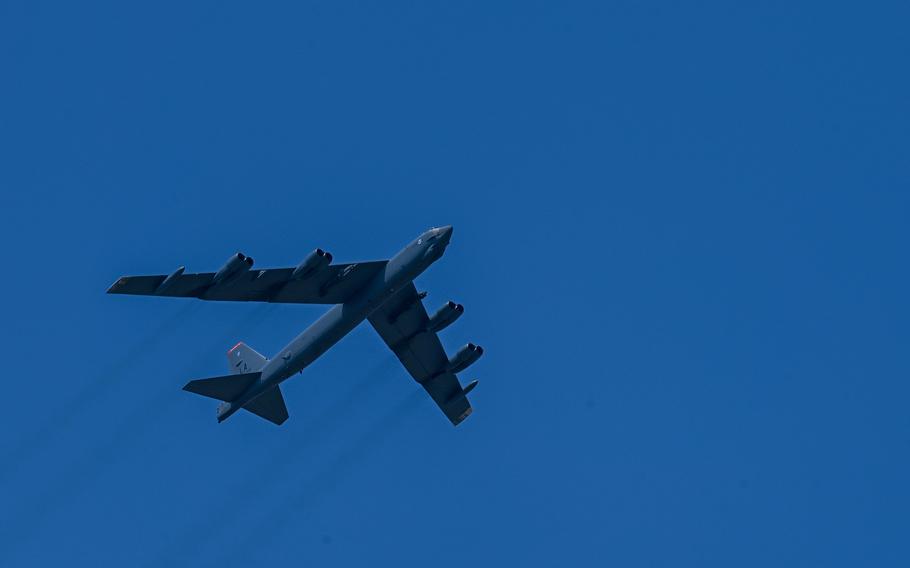
A B-52 Stratofortress from the 2nd Bomb Wing returns home to Barksdale Air Force Base, La., following a Bomber Task Force mission at Andersen Air Force Base, Guam, Aug. 20, 2023. (Seth Watson/U.S. Air Force)
SEOUL, South Korea — The first B-52H Stratofortress to land on the Korean Peninsula in at least 30 years may become the centerpiece of aerial drills between the U.S., South Korea and Japan.
The bomber touched down Tuesday afternoon at Cheongju International Airport, about 60 miles south of Seoul, a Ministry of National Defense official told Stars and Stripes by phone Wednesday on a customary condition of anonymity.
The B-52 also flew over the capital alongside at least four South Korean F-35A Lightning II stealth fighters for a defense exhibition in Seoul, according to photos released by the ministry Tuesday.
The bomber’s visit reinforces the United States’ “ironclad commitment” to defend the South from a North Korean attack, according to a USFK news release Monday.
Fighter jets from the U.S., South Korea and Japan will escort the B-52 during an aerial drill over the peninsula on Sunday, an unnamed South Korean military official told the Yonhap News Agency for a report Wednesday.
South Korea’s Ministry of Defense declined to confirm the report in a statement Wednesday but said Seoul will continue to conduct trilateral training due to North Korea’s nuclear and missile threats.
U.S. Forces Korea spokesman David Kim also declined to confirm the report in an email Wednesday, citing the command’s policy of not commenting on planned joint exercises.
North Korea has fired 21 ballistic missiles in 14 separate days of testing so far this year, including a solid-fueled Hwasong-18 intercontinental ballistic missile launched July 12. It flew for roughly 74 minutes and theoretically could have reached the continental United States.
On Aug. 18, President Joe Biden, South Korean President Yoon Suk Yeol and Japanese Prime Minister Fumio Kishida held the first-ever standalone summit between their countries at Camp David, Md., where they ushered in a “new era of trilateral partnership” in the wake of North Korean threats.
“We are committed to pursuing enhanced ballistic missile defense cooperation to counter [North Korea’s] nuclear and missile threats,” a joint statement said. “We reaffirm that achieving a world without nuclear weapons is a common goal for the international community, and we continue to make every effort to ensure that nuclear weapons are never used again.”
Biden and Yoon also agreed to boost the U.S. military’s presence in South Korea through regular deployments of strategic assets.
The USS Kentucky made a port call at Busan in July, marking the first such visit by a U.S. ballistic missile submarine since 1981.
Nearly two months after the Camp David summit, South Korea and Japan conducted a maritime exercise with the Ronald Reagan Carrier Strike Group in international waters near Seoul’s Jeju Island.
The two-day training, which kicked off Oct. 9, focused on maritime interdiction — stopping, boarding and searching vessels at sea — and anti-piracy drills, according to South Korea’s military.
The drill led by the USS Ronald Reagan aircraft carrier included South Korea’s Yulgok Yi I, a destroyer equipped with the Aegis missile-defense system and the Japanese Maritime Self-Defense Force’s JS Hyuga destroyer.
“Our continued dialogue … demonstrate our shared resolve to maintain the status quo of peace and defend against aggression,” U.S. 7th Fleet’s commander, Vice Adm. Karl Thomas, said in a Navy news release at the time.
The Ronald Reagan is the second U.S. aircraft carrier to visit South Korea so far this year. The USS Nimitz docked in Busan on March 28 for the two-week Ssangyong exercise.